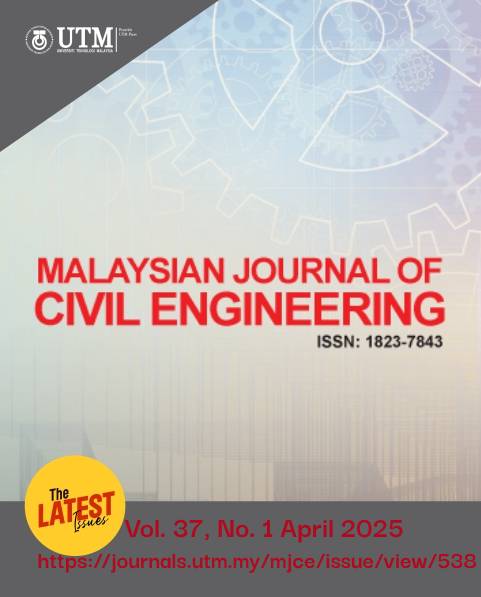VALIDATION FOR FINITE ELEMENT ANALYSIS OF FREE-SPANNING SUBSEA PIPELINE USING THEORETICAL FORMULA
DOI:
https://doi.org/10.11113/mjce.v37.24088Keywords:
Free-spanning pipeline, Finite Element Method (FEM), FEM validation, beam theory, static analysis, deflectionAbstract
Hydrocarbon products from offshore sources are primarily transported to onshore facilities using subsea pipelines, which typically rest on the seabed. To ensure safe operation and prevent failure, engineers must assess the reliability of these free-spanning pipelines, which are prone to structural risks due to uneven seabed conditions. The finite element method (FEM) is widely used for structural analysis due to its flexibility in modelling complex structures. Validation of FEM is essential for verifying its accuracy, typically against physical experiments or reliable theoretical data. This study validates a finite element (FE) model for the static analysis of free-spanning subsea pipelines by comparing FEM predictions with Euler-Bernoulli and Timoshenko beam theories. The pipeline model, developed in Abaqus, was evaluated across various length-to-diameter (L/D) ratios. Results show that for L/D < 140, FEM predictions align with beam theory, exhibiting errors below 2%. However, for L/D > 160, FEM deviations exceed 30%, indicating nonlinear effects beyond the range of beam models. These findings refine the applicability of DNV-RP-F105 guidelines, enhancing pipeline integrity assessment methodologies in offshore engineering. The validated FEM model offers confidence for further evaluation of pipeline integrity under combined loading or defects.
References
Belytschko, T., Liu, W. K., Moran, B., & Elkhodary, K. 2014. Nonlinear finite elements for continua and structures. John wiley & sons.
Chee, J., Walker, A., & White, D. 2018. Controlling lateral buckling of subsea pipeline with sinusoidal shape pre-deformation. Ocean Engineering, 151: 170–190.
Choi, J. B., Goo, B. K., Kim, J. C., Kim, Y. J., & Kim, W. S. 2003. Development of limit load solutions for corroded gas pipelines. International Journal of Pressure Vessels and Piping, 80(2): 121–128.
Gee, A. 2021. Dynamic Finite Element (DFE) Formulation of Functionally Graded Beams. Toronto Metropolitan University. Thesis. https://doi.org/10.32920/ryerson.14654586.v1
Grondin, T. L., Gordon, A. P., & Yavas, D. 2024. Exploring flexural behavior of additively manufactured sandwich beams with bioinspired functionally graded cores. Journal of Sandwich Structures & Materials, 26(6), 969–989.
Hwang, W., & Lee, J. S. 2019. Analytical Model for the Structural Behavior of Pipelines During Lowering-In. Applied Sciences, 9(13): 2595.
Khiem, N. T. 2017. A closed-form solution for free vibration of multiple cracked Timoshenko beam and application. Vietnam Journal of Mechanics, 39(4): 315–328.
Lo, M., Vijaya Kumar, S. D., Karuppanan, S., & Ovinis, M. 2022. An artificial neural network-based equation for predicting the remaining strength of mid-to-high strength pipelines with a single corrosion defect. Applied Sciences, 12(3): 1722.
Meng, X., Xiao, F., Yan, Y., Chen, G. S., & Ma, Y. 2023. Non-Destructive Damage Evaluation Based on Static Response for Beam-like Structures Considering Shear Deformation. Applied Sciences. 13: 8219, 13(14): 8219. https://doi.org/10.3390/APP13148219
Monacchi, G., Arcangeletti, G., Pigliapoco, M., Catena, P., Ziero, L., Castriotta, G., & Loi, A. 2023. An Innovative Set of Tools for a Sustainable and Safe Offshore Pipelaying. Offshore Technology Conference, D041S055R008.
Phuor, T., Trapper, P. A., & Ganz, A. 2023. An Analytical Expression for the Fundamental Frequency of a Long Free-Spanning Submarine Pipeline. Mathematics, 11(21): 4481.
Rui, S., Zhang, H., Xu, H., Zha, X., Xu, M., & Shen, K. 2024. Seabed structures and foundations related to deep‐sea resource development: a review based on design and research. Deep Underground Science and Engineering, 3(2): 131–148.
Shittu, A. A., Kara, F., Aliyu, A., & Unaeze, O. 2019. Review of pipeline span analysis. World Journal of Engineering, 16(1): 166–190.
Su, Y. C., & Ma, C. C. 2011. Theoretical analysis of transient waves in a simply-supported Timoshenko beam by ray and normal mode methods. International Journal of Solids and Structures, 48(3–4): 535–552.
Thang, D. 2021. An Improved Method Of Calculating Beam Deformation Considering Transverse Shear Strain. Geomate Journal, 21(83), 109–116.
Wu, K., Zheng, G., & Chen, G. 2023. Extending timoshenko beam theory for large deflections in compliant mechanisms. Journal of Mechanisms and Robotics, 15(6): 061012.
Yıldırım, V. 2018. Some closed-form bending formulas for elastically restrained Euler-Bernoulli beams under point and uniformly distributed loads. Journal of Applied Mathematics and Computational Mechanics, 17(3): 97–109.
















